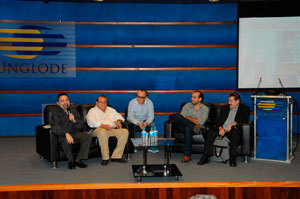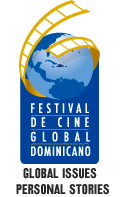
(Santo Domingo, November 15, 2012) – As part of the VI Dominican Global Film Festival’s series of workshops and panels, film professionals and interested individuals met to discuss, “The Role of the Press in Film” with local journalists Félix Manuel Lora and Alfonso Quiñones and international writers such as Carlos Arciniegas (CNN), Jorge Cámara (Hollywood Foreign Press Association) and Carlos Gómez Iniesta (Cine Premiere) who joined the round table discussion on the hidden protagonist in the film industry: the critic.
such as Carlos Arciniegas (CNN), Jorge Cámara (Hollywood Foreign Press Association) and Carlos Gómez Iniesta (Cine Premiere) who joined the round table discussion on the hidden protagonist in the film industry: the critic.
Generating Content
The panel began with words from the young Mexican writer, Carlos Gómez Iniesta who provided graphic material with his talk about the work of the media whose beat is the film world. "An editor usually asks for information from the reporter and this is the first challenge: getting the information from a primary source. There are press junkets that take reporters from one place to another to visit film sets. Often when visiting a film studio, reporters are limited by the studios to only asking questions having to do with the film being made there at the moment. Any attempt to get information about the private life of the actor or director results in the cancellation of the meeting. Then there are the phone interviews which are usually limited to around 15 minutes,” said Gómez Iniesta.
"But the work doesn’t end there. There are embargos and retention of information. When a reporter is invited onto a set, he or she may be prohibited from publishing certain information for a stipulated amount of time. The role of the publicist is also vital in getting one’s information published. It is fair to say that between the publicist and the critic there is a healthy rivalry: our work is mutually complementary.”
The Press of Yesterday and Today
Jorge Cámara, veteran and prestigious Latin critic in the United States, referred to the changes that have occurred over time in the relationship between the press and the film world. "In the past, the studios respected the press. Now they protect their people, they want to keep them out of sight. I have never accepted to just talk about the movie. The public is interested in other aspects and the film critic needs to appreciate, value and transmit that information. Today there are very few human-interest stories being told. For that reason, Hollywood film today is disappointing. There are drawings or comic strips. Regardless of all this, it is still gratifying work. It is a pleasure to work as a film critic.”
Juan Carlos Arciniegas of CNN said film reviewing goes beyond the written press. “Today we are all critics, thanks to social networks.” He added that art criticism is connected to social responsibility in which critics should stay away from absolutism and prejudices and stay in the area of culture. “It was my great pleasure to promote the 2011 Dominican film, Jaque Mate, and interviewing Kristin Stewart.”
Film Criticism in the DR
For Felix Manuel Lora, film criticism is completely indispensable and very important. "Must we provide a summary of the film and critical comments? Art critics must provide details and context of the films. Our usefulness is this: help understand audiovisual codes because if you don’t understand art, you won’t understand society,” he stressed. “In the Dominican Republic, the incipient film industry is developing. The opinion of film critics and writers is much more appreciated and taken into account than ever before.”
Alfonso Quiñones, in his talk, added "a work of art or film is not complete until the public sees it and the critics evaluate it. Film and the film critic have a love-hate relationship that benefits culture. The public-artist relationship uses us as their intermediary. Dominican film does not have a sophisticated culture when it comes to film. We are talking about the language of film and structure because film is a formula. The critic is the one to say whether it worked or not. This is our role within society."
He prefers to write after seeing the movie because “criticism is not absolute but rather an interpretation that can be had in an instant. It is recommended to get professionally and culturally prepared. One has to have criteria and be brave, armed with nerves of steel. The artwork is the only project being presented by the author. It is this artwork that is being criticized, not the artist. Who wants to be an art critic? Begin by reading. Read, read and read some more.”









